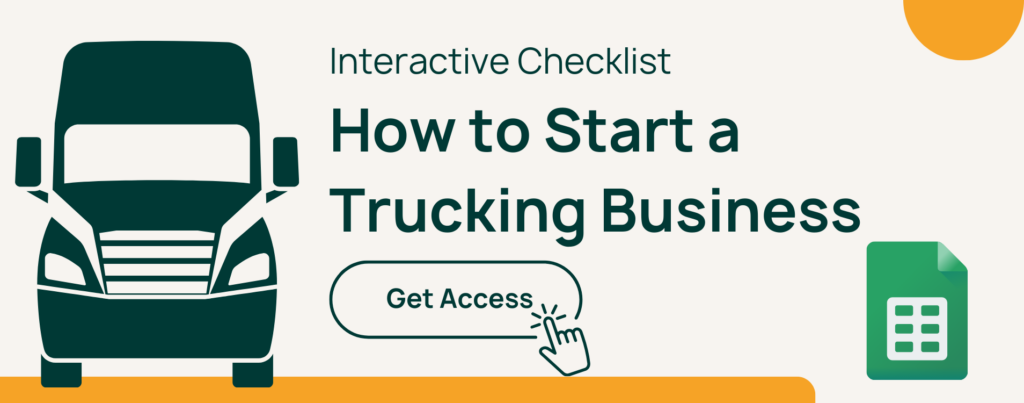The 6 Questions A Trucking Business Plan Should Answer
The internet is full of trucking business plan templates. These examples tend to include a lot of the same elements:
- An executive summary
- A list of service offerings
- Market analysis
- Company organization/personnel lists
- Financial reporting
- Budget projections
- Some sort of operational strategy
- Maybe a SWOT analysis (a list of strengths, weaknesses, opportunities, and threats for your business)
These templates can be useful, but they skip over a more fundamental issue:
What is your business plan for? What is its purpose?
Only you can answer that question, and your response may change the way you approach the project. (And for more details on the financial nuts and bolts of running a trucking business, see our sidebar below.)
Financial Benchmarks for Your Trucking BusinessesAs you compile financial data for your business plan, you may wonder how your numbers stack up. There’s no standard set of figures that determine success or failure, of course. Every business is different. But in general terms, here are a few financial goals that tend to lead to success for owners of trucking businesses. 1. How much capital does it take to start a trucking company?We estimate the costs of starting a trucking business to be between $5,200 and $28,050. Here’s how that breaks down:
2. How much monthly revenue do you need to stay financially healthy?Most carriers do best with a monthly revenue target of around $22,500. That translates to 10,000 miles per month, with a freight rate of $2.25/per mile. Based on this per-mile rate, owner-operators usually cover costs with around 4,000 miles per month. With the added expense of driver pay, company trucks need about 7,000 miles per month to break even. Everything beyond those limits is profit. That means an owner-operator driving 10,000 miles per month at $2.25 per mile would bring in profits of $13,500 per month. Company trucks meeting the same goal turn less profit per truck, but multi-truck carriers generate more income through scale. 3. How many miles per month should you target for a healthy profit margin?Owner-operators and carriers alike typically thrive on 10,000 to 12,000 miles per month, per truck. That breaks down to about 500 to 600 miles per shift, assuming a five-day work week, or 20 workdays per month. This calculation also assumes the per-mile rate of $2.25. |
One carrier may seek funding; that requires a business plan built for banks or investors, heavy on financial reports and projections. An established fleet owner, on the other hand, may need a clear strategy for the next three years. In that case, the writer and audience are one, and the plan will focus on detailed operational steps.
A strong business plan for your trucking company can help you clarify goals, prepare for a changing future, and make smart decisions along the way. It can attract key partners. It can also help secure the funding you need to grow. But depending on your goal, that business plan may look very different indeed—and a cookie-cutter template may not work for your unique situation.
To create an effective business plan, start by determining the information your audience is looking for (even if that audience is just you). Whether you’re enticing investors or simply trying to bring order to your operation, most trucking business plans should answer a few simple questions. Here they are, followed by some resources that can help you create the perfect business plan for your trucking operation.

6 Questions Every Trucking Business Plan Should Answer
Let’s start with a more general question: What is a business plan?
At the simplest level, a business plan is a collection of three pieces of information:
- Business goals
- A strategy for achieving those goals
- Data that suggests the strategy will work
Business plans can take many forms. One might be a traditional written document. Another might be a website. Increasingly, cloud-based reporting tools fulfill the functions of a business plan, allowing company founders and their stakeholders to share relevant data in real time.
Regardless of how it’s presented—or your chapter headings—a business plan is essentially a list of answers. But to what questions?
In journalism school, they teach reporters to focus on the “5 Ws and an H” for every news report. That’s who, what, when, where, why, and how. This approach works pretty well for evaluating trucking business plans, too, even if we’d swap the order of the Ws a bit.
If your plan answers the six questions below, then, it’s probably headed in the right direction:
1. What is your business trying to accomplish?
Looking at your business plan, does the reader get a clear idea of your business goals? We don’t just mean revenue projections (although you’ll certainly want to include those, too). Readers should understand the type of freight you plan to carry and the sorts of businesses you hope to serve.
You may answer this question in your executive summary, your mission statement, your list of service offerings, or all three. A narrative answer is a great place to start: “I’ve been a company driver for 10 years, and I’ve identified a few under-served lanes I’d like to cover with my own fleet,” for example.
2. Why do you want to meet this particular set of goals?
Loan officers may not need much of a narrative; they’ll probably zero in on your financials. But a certain type of investor needs to know your story—and understanding your own motivations can help clarify strategic goals as you continue.
Maybe you live near a particular manufacturing hub and you’ve seen the struggle to establish strong inbound/outbound logistics lanes. Maybe you grew up in a farming family and remember the challenge of expensive refrigerated freight. You don’t need to write a novel, and you don’t need a humanitarian reason to go into business. But explaining why you started your trucking company shows the essential nature of your company and what makes it unique.
The best places to answer this question are in the executive summary and/or in your founder’s bio. Just a few sentences will do.
3. Who is your target audience?
This question should be answered by your market research, including the demographic data for your ideal clients. Have you discovered a local niche, like a logistics hub that remains underserved? In that case, you may have a very specific client base in mind. Or are you an owner-operator working the spot market? You can still narrow your preferred clients down by freight type, pay rates, and lanes.
And speaking of lanes, your geographical area of service is an important detail to present in a trucking company business plan. That takes us to the next item on our list.
4. Where are the markets you’ll serve?
If you hope to stay within a certain area—however many miles surrounding whatever city, for instance—include this in your executive summary. You might even add a chapter about markets, covering who and where they are in detail. Support your choices with market information about your operating region or regions, including prospects and competitors. The same is true if you plan to operate nationally or internationally, of course.
5. When will you reach the milestones that lead to goal completion?
Your financial section should include both past data (if you’ve already been operating) and projections for the future. You might break down sales projections by year, quarter, or even month.
You might also list a specific project timeline or list of deadlines for goals over the next few months or years. Doing so informs stakeholders of your plans and gives you specific metrics for evaluating your own performance. The important thing is to give the reader some idea of when you’ll achieve particular business milestones.
6. How do you plan to meet your goals?
This is the big question. Most of your business plan will be concerned with how. That’s what a plan is, after all: a list of steps explaining how you get from one metaphorical place to another. Try breaking the question down into a series of smaller ones:
- How will you fund your trucking company?
- How much do you need to start the company?
- How much will you need to make per month to make the company profitable?
- How will you get the equipment you need?
- How will you grow your business once it’s established?
- How are you establishing the business in the first place?
- How many competitors are in your area of operation?
There’s no real end to the how questions. That’s the challenge of writing a trucking company business plan. But there are some simple ways to make it easier. Here are a few more resources that can help you create an effective business plan for your trucking company.
More Resources For Creating A Trucking Business Plan
Lots of resources are available to help you write a great trucking business plan. You can start with online research, articles like this one, or the templates we mentioned in the intro. But more in-depth assistance is also available.
The U.S. Small Business Association (SBA) is a great place to start. This organization offers low-cost—or even free—counseling, training, and more. Just visit the SBA Local Assistance page and enter your business zip code to find help near you.
Or you could go the technology route. There are plenty of business plan apps that allow you to simply fill in the blanks, generating an organized document based on your responses. Examples of business plan software include:
It’s not a bad idea to pay a small cost for tools or consulting. But even if your budget is limited, don’t hesitate to seek out experienced owner-operators and fleet owners. Ask about their experience with business plans; you’d be surprised how much people are willing to share. And if your trucking company is already operating and you’re still having trouble with the budget, check out our list of 20 ways to improve your profit margins.
Regardless of whether you’re creating your first business plan for a start-up, or just planning for the next three-year cycle, profit isn’t the only financial challenge in the industry. Cash flow can also be an issue, since brokers and shippers often take weeks or even months to pay.
Luckily, there’s a solution to cash flow problems in the trucking industry: factoring. If you have open invoices, Bobtail offers a simple way to factor them. That means you get paid today, for the price of a single, low factoring fee.
With a solid trucking business plan, you’re off to a great start. Next, keep cash flowing with low-cost factoring services from Bobtail. Learn more today.




